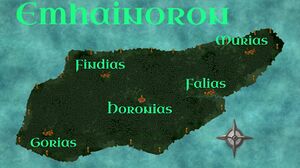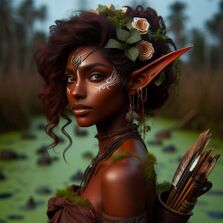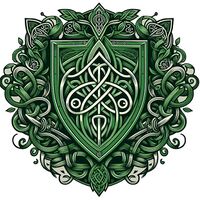Emhain (Aurora): Difference between revisions
| Line 1: | Line 1: | ||
Emhain, also known as Emhainoron, is a small Elven Confederacy located on the island of Emhain, an island of stunning beauty, thick vegetation, and isolation. The island is located in the far North, surrounded by vast oceans and rugged coastlines, making it a region that remains relatively untouched by foreign influence. Despite its modest size, Emhain is known for its rich cultural heritage, deep connection to nature, and intricate political system. | '''Emhain''', also known more formally as '''Emhainoron''', is a small Elven Confederacy located on the island of Emhain, an island of stunning beauty, thick vegetation, and isolation. The island is located in the far North, surrounded by vast oceans and rugged coastlines, making it a region that remains relatively untouched by foreign influence. Despite its modest size, Emhain is known for its rich cultural heritage, deep connection to nature, and intricate political system. | ||
{{Infobox country | image_flag = | flag_type = [[Flag|Flag]] | image_coat = [[File:Emhain shield.jpg|200x200px]] | symbol_type = [[Imperial Coat Of Arms|Coat Of Arms]] | national_motto = ''"..."'' | englishmotto = ''"..."'' | national_anthem = ''"May I grow here"'' | image_map = [[File:Emhainoron.jpg|thumb]] | map_caption = Territories of the Island. | capital = '''Horonias (but only in times of war), otherwise rotational''' | coordinates = | largest_city = Falias | official_languages = '''[[Language 1]]'''<br>'''[[Language 2]]''' | ethnic_groups = [[Lothlondir]] | demonym = Emhainean | currency = [Lulu] | currency_code = [ELL] | time_zone = | date_format = dd/mm/yyyy | drives_on = Left | cctld = | calling_code = }} | {{Infobox country | image_flag = | flag_type = [[Flag|Flag]] | image_coat = [[File:Emhain shield.jpg|200x200px]] | symbol_type = [[Imperial Coat Of Arms|Coat Of Arms]] | national_motto = ''"..."'' | englishmotto = ''"..."'' | national_anthem = ''"May I grow here"'' | image_map = [[File:Emhainoron.jpg|thumb]] | map_caption = Territories of the Island. | capital = '''Horonias (but only in times of war), otherwise rotational''' | coordinates = | largest_city = Falias | official_languages = '''[[Language 1]]'''<br>'''[[Language 2]]''' | ethnic_groups = [[Lothlondir]] | demonym = Emhainean | currency = [Lulu] | currency_code = [ELL] | time_zone = | date_format = dd/mm/yyyy | drives_on = Left | cctld = | calling_code = }} | ||
== Etymology == | == Etymology == | ||
The word ''Emhain'' reflects an Elven concept of "sacred earth" or "eternal land," with ''em-'' potentially suggesting "eternal" or "ancient," and ''-hain'' meaning "land" or "domain." | The word ''Emhain'' reflects an Elven concept of "sacred earth" or "eternal land," with ''em-'' potentially suggesting "eternal" or "ancient," and ''-hain'' meaning "land" or "domain." | ||
== Race == | |||
[[File:Female Lothlondir.jpg|thumb|223x223px|A Female Lothlondir]] | |||
In the lands of Emhain, the Lothlondir, also known as the Swamp Elves, reign as the dominant race, their culture deeply intertwined with the marshes, wetlands, and verdant swamps that define the region. These elves are renowned for their affinity with nature, particularly the rich and often mystical flora of the swamp, which they cultivate and protect. However, a distinct merchant community of Dwarves has established itself in the nearby region of '''Falías''', where they have found success through trade and craftsmanship. These dwarves, unlike their Swamp Elf counterparts, have made their mark by establishing bustling trading posts and markets, where fine metals, rare gems, and handcrafted goods are exchanged. Though their presence is more urban and commercial in nature, they maintain a strong bond to their ancestral traditions, particularly those of mining, metalwork, and stonecraft. The Dwarves of Falías have become essential intermediaries between the Lothlondir and the outside world, fostering both economic exchange and cultural dialogue in a land where elves rule and dwarves navigate the complex social fabric as valuable outsiders. | |||
== History == | == History == | ||
| Line 45: | Line 48: | ||
== Geography == | == Geography == | ||
The climate and ecology of Emhain are shaped by its extensive wetlands, dense forests, and rich, verdant swamps. These environments are critical to the cultural and economic life of the Lothlondir (Swamp Elves), who have adapted to this unique landscape over generations. Below is an outline of the climate and ecological features that define Emhain: | |||
=== Climate === | === Climate === | ||
Emhain experiences a humid subtropical climate, characterized by warm temperatures, high humidity, and frequent rainfall throughout the year. The region is marked by: | |||
* Mild Winters: Temperatures in winter rarely dip below 10°C (50°F), with brief cool spells being the exception rather than the norm. While snowfall is rare, the damp conditions make the winters feel colder than they actually are. | |||
* Hot and Wet Summers: Summer temperatures hover around 25-30°C (77-86°F), but high humidity levels often make it feel warmer. Rainfall is abundant, with seasonal monsoons bringing heavy downpours that contribute to the swelling of rivers and marshes, further saturating the swampy landscape. | |||
* Frequent Fog and Mist: Due to the dense moisture in the air and the low-lying marshlands, Emhain is often enveloped in thick morning fog, especially in the early hours. The fog adds a sense of mystery to the landscape, as the sunlight often struggles to break through. | |||
=== Ecology === | === Ecology === | ||
The ecology of Emhain is defined by its wetland ecosystems, which are teeming with both plant and animal life. The Lothlondir’s deep connection with the land shapes their ways of life, as they interact harmoniously with the unique biomes that surround them. Key elements of Emhain’s ecology include: | |||
* Swamps and Wetlands: The vast swamplands are dotted with stagnant pools, bogs, and slow-moving rivers that form an interconnected water system. These swamps are home to a variety of plant species, such as cypress trees, mosses, and swamp flowers that bloom brightly despite the constant dampness. These plants are of cultural significance to the Lothlondir, who use them in healing rituals and as ingredients in their potent herbal medicines. | |||
* Flooded Forests: Emhain’s wetland forests consist of waterlogged hardwoods and softwoods, with species like willows, oaks, and mangrove trees growing along the edges of the wetlands. The trees' thick roots often emerge from the water, creating natural platforms and walkways that the Lothlondir use to navigate the swamp. The trees’ leaves and bark provide natural camouflage, blending seamlessly into the swamp environment. | |||
* Biodiversity: The wetlands and forests of Emhain host an array of species, many of which are unique to the region. Among the notable fauna are semi-aquatic creatures like swamp frogs, aquatic serpents, and swamp wolves—which are smaller, more agile creatures adapted to the wetland environment. The Lothlondir are skilled hunters and herbalists, using the swamp’s bounty to their advantage. In addition, swamp birds such as herons and kingfishers are common, along with insects like mosquitoes, dragonflies, and fireflies, which thrive in the humid conditions. | |||
* The Lothlondir’s Sacred Groves: Deep within the swamps, the Lothlondir maintain sacred groves—regions of untouched, ancient forest where the Lothlondir go to commune with nature and carry out important rituals. These groves are seen as places of power, rich with flora and fauna that hold spiritual significance. | |||
* Floodplains and Marshes: Emhain's rivers, fed by the summer monsoons, frequently overflow, creating vast marshlands rich in nutrients. These marshes are teeming with life, hosting water plants like water lilies, reeds, and algae, which provide sustenance for both animals and the elves of Emhain. The mud-rich floodplains offer fertile ground for unique species of fungi, moss, and herbs that the Lothlondir use in their rituals and daily life. | |||
* Migratory Species: The swamp ecosystem of Emhain also attracts numerous migratory species. Birds like swans, storks, and geese make their way through the wetlands, stopping to nest in the soft, wetland grasses. These species are crucial to the local food chain, and their seasonal movements are keenly observed by the Lothlondir. | |||
== Government and Politics == | == Government and Politics == | ||
Revision as of 14:24, 13 November 2024
Emhain, also known more formally as Emhainoron, is a small Elven Confederacy located on the island of Emhain, an island of stunning beauty, thick vegetation, and isolation. The island is located in the far North, surrounded by vast oceans and rugged coastlines, making it a region that remains relatively untouched by foreign influence. Despite its modest size, Emhain is known for its rich cultural heritage, deep connection to nature, and intricate political system.
Motto: "..." "..." | |
Anthem: "May I grow here" | |
 Territories of the Island. | |
| Capital | Horonias (but only in times of war), otherwise rotational |
|---|---|
| Largest city | Falias |
| Official languages | Language 1 Language 2 |
| Ethnic groups | Lothlondir |
| Demonym(s) | Emhainean |
| Currency | [Lulu] ([ELL]) |
| Date format | dd/mm/yyyy |
| Driving side | left |
Etymology
The word Emhain reflects an Elven concept of "sacred earth" or "eternal land," with em- potentially suggesting "eternal" or "ancient," and -hain meaning "land" or "domain."
Race

In the lands of Emhain, the Lothlondir, also known as the Swamp Elves, reign as the dominant race, their culture deeply intertwined with the marshes, wetlands, and verdant swamps that define the region. These elves are renowned for their affinity with nature, particularly the rich and often mystical flora of the swamp, which they cultivate and protect. However, a distinct merchant community of Dwarves has established itself in the nearby region of Falías, where they have found success through trade and craftsmanship. These dwarves, unlike their Swamp Elf counterparts, have made their mark by establishing bustling trading posts and markets, where fine metals, rare gems, and handcrafted goods are exchanged. Though their presence is more urban and commercial in nature, they maintain a strong bond to their ancestral traditions, particularly those of mining, metalwork, and stonecraft. The Dwarves of Falías have become essential intermediaries between the Lothlondir and the outside world, fostering both economic exchange and cultural dialogue in a land where elves rule and dwarves navigate the complex social fabric as valuable outsiders.
History
Prehistory
The prehistory of Emhain is steeped in myths of the world’s creation and the rise of the Elven people, a period shrouded in mystery where the veil between history and myth is thin. Here is a look at some of the foundational elements of Emhain’s early lore:
The Breath of Djuruva
In Emhainean cosmology, Djuruva—the god or essence of cosmic balance and life—breathed Emhain into existence as a lush realm meant to sustain life in harmony. Djuruva scattered Wakwak seeds throughout Emhain, believed to be enchanted seeds that grew into ancient trees with mystical properties. These Wakwak trees provided the earliest Elven ancestors with shelter, wisdom, and a source of spiritual connection, and it is said that they could communicate with the elves, guiding them and granting them visions of the spirit world.
The Age of Five Kings
The Unification
The Wars with the Archothirian Empire
Modern Times
Culture
Cuisine
In Emhain, the cuisine of the swamp elves revolves around the abundance and diversity of the lush, mystical wetlands. Swamp elven cooking is not only vegan but is infused with a deep reverence for the environment, each dish designed to honor the flavors, colors, and medicinal properties of their ecosystem.
1. Core Ingredients: The elves gather a colorful array of aquatic and marshland plants like edible water lilies, wild rice, duckweed, swamp tubers, ferns, and mosses. They also cultivate mushrooms that grow in the shade of the bogs, along with floating herbs like marsh mint, fennel, and wild cress. Fruit-bearing shrubs, like the crimson darlberries and the juicy tang-lemon, add natural sweetness to their creations.
2. Preparation and Techniques: Emhain cuisine celebrates natural textures and earthy flavors, favoring minimal heat or fermentation to preserve nutrients. They cook with bog stones that retain warmth over low, smoky fires. Wood-smoked flavors are common, especially when grilling flatbreads or steaming root vegetables wrapped in edible marsh leaves. Swamp elves are also known for their skillful fermentation, creating savory pastes, potent herbal brews, and tangy moss sauces.
3. Signature Dishes:
- Lilyfruit Stew: A thick, fragrant stew combining lily fruits, tubers, and wild marsh herbs, slow-cooked with a hint of spice from bark shavings and a dash of sourberry juice.
- Fenroot Porridge: A comforting dish made from ground fenroot, wild rice, and roasted mushrooms, often enjoyed with a drizzle of darlberry nectar or a garnish of crisped cress.
- Spiced Moss Cakes: Tiny cakes crafted from marsh moss mixed with fenmeal and seasoned with swamp spices. These cakes are lightly fried on hot stones and served with a spread of fermented mushroom paste.
- Bogroot Flatbreads: Dense, nutrient-rich flatbreads made from ground bogroots, served fresh from the coals and topped with spicy tang-lemon zest or smoked water lily seeds.
- Frostweed Tea: A refreshing, floral tea brewed from frostweed and marsh mint, which is believed to promote clarity and calm.
4. Herbal and Medicinal Brews: Swamp elves are herbalists by nature, often incorporating medicinal herbs into their diet. Teas made from fenflower or water willow are popular, as are fermented "healing broths" that combine nutrient-rich mosses, root extracts, and floating herb infusions.
5. Dining Rituals: Dining in Emhain is a ritual of gratitude, where meals are seen as offerings to the earth as much as sustenance. Elves dine communally, arranging dishes on woven moss platters and serving them with carved driftwood utensils. Meal preparation and eating are done with reverence, enhancing the spiritual connection between swamp elves and the land.
Geography
The climate and ecology of Emhain are shaped by its extensive wetlands, dense forests, and rich, verdant swamps. These environments are critical to the cultural and economic life of the Lothlondir (Swamp Elves), who have adapted to this unique landscape over generations. Below is an outline of the climate and ecological features that define Emhain:
Climate
Emhain experiences a humid subtropical climate, characterized by warm temperatures, high humidity, and frequent rainfall throughout the year. The region is marked by:
- Mild Winters: Temperatures in winter rarely dip below 10°C (50°F), with brief cool spells being the exception rather than the norm. While snowfall is rare, the damp conditions make the winters feel colder than they actually are.
- Hot and Wet Summers: Summer temperatures hover around 25-30°C (77-86°F), but high humidity levels often make it feel warmer. Rainfall is abundant, with seasonal monsoons bringing heavy downpours that contribute to the swelling of rivers and marshes, further saturating the swampy landscape.
- Frequent Fog and Mist: Due to the dense moisture in the air and the low-lying marshlands, Emhain is often enveloped in thick morning fog, especially in the early hours. The fog adds a sense of mystery to the landscape, as the sunlight often struggles to break through.
Ecology
The ecology of Emhain is defined by its wetland ecosystems, which are teeming with both plant and animal life. The Lothlondir’s deep connection with the land shapes their ways of life, as they interact harmoniously with the unique biomes that surround them. Key elements of Emhain’s ecology include:
- Swamps and Wetlands: The vast swamplands are dotted with stagnant pools, bogs, and slow-moving rivers that form an interconnected water system. These swamps are home to a variety of plant species, such as cypress trees, mosses, and swamp flowers that bloom brightly despite the constant dampness. These plants are of cultural significance to the Lothlondir, who use them in healing rituals and as ingredients in their potent herbal medicines.
- Flooded Forests: Emhain’s wetland forests consist of waterlogged hardwoods and softwoods, with species like willows, oaks, and mangrove trees growing along the edges of the wetlands. The trees' thick roots often emerge from the water, creating natural platforms and walkways that the Lothlondir use to navigate the swamp. The trees’ leaves and bark provide natural camouflage, blending seamlessly into the swamp environment.
- Biodiversity: The wetlands and forests of Emhain host an array of species, many of which are unique to the region. Among the notable fauna are semi-aquatic creatures like swamp frogs, aquatic serpents, and swamp wolves—which are smaller, more agile creatures adapted to the wetland environment. The Lothlondir are skilled hunters and herbalists, using the swamp’s bounty to their advantage. In addition, swamp birds such as herons and kingfishers are common, along with insects like mosquitoes, dragonflies, and fireflies, which thrive in the humid conditions.
- The Lothlondir’s Sacred Groves: Deep within the swamps, the Lothlondir maintain sacred groves—regions of untouched, ancient forest where the Lothlondir go to commune with nature and carry out important rituals. These groves are seen as places of power, rich with flora and fauna that hold spiritual significance.
- Floodplains and Marshes: Emhain's rivers, fed by the summer monsoons, frequently overflow, creating vast marshlands rich in nutrients. These marshes are teeming with life, hosting water plants like water lilies, reeds, and algae, which provide sustenance for both animals and the elves of Emhain. The mud-rich floodplains offer fertile ground for unique species of fungi, moss, and herbs that the Lothlondir use in their rituals and daily life.
- Migratory Species: The swamp ecosystem of Emhain also attracts numerous migratory species. Birds like swans, storks, and geese make their way through the wetlands, stopping to nest in the soft, wetland grasses. These species are crucial to the local food chain, and their seasonal movements are keenly observed by the Lothlondir.
Government and Politics
Judicial System
Tax Districts
Coinage
Transportation and Communication
Foreign Relations
Famous for its many defensive wars against the Archothirian Empire.
